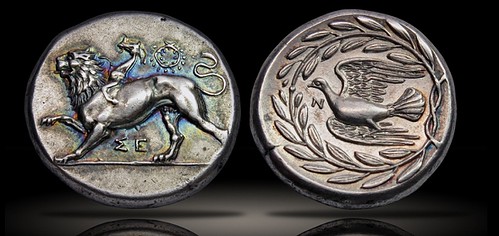
PREV ARTICLE
NEXT ARTICLE
FULL ISSUE
PREV FULL ISSUE
THE SIKYON STATER
An article by Russell A. Augustin published May 7, 2015 on CoinWeek discusses the Sikyon Stater. Gorgeous coin! -Editor

Sikyon was located in the northern Peloponnesus and was known in antiquity for its industries, including sculpture, bronze work, and pottery. Its central location meant it was frequently involved in the wars of its neighbors: Thebes, Corinth, Athens, and Sparta. It was the main mint for the anti-Athenian states in the Peloponnesian War and issued a substantial number of coins, most of which were melted down to finance further conquests. Sikyon was the cradle of western art, credited with originating tragedy in theater, the modern art of painting as it still stands today, and the invention of using multiple instruments arranged orchestrally. The great sculptors Polykleitos and Lysippos both studied at the famous schools in Sikyon. This coin comes from an issue of staters produced at Sikyon after Alexander the Great’s request for mercenaries from the Peloponnese in 334 BCE. They seemed to have been paid out as a signing bonus and then buried for safe-keeping. Unfortunately, many of these mercenaries never came back, explaining why many coins of this type still exist today and were never melted down. The coin depicts a chimera, a mythical, fire-breathing monster composed of parts of three animals: a lion with the head of a goat arising from its back and a tail that ends in a snake’s head, walking proudly to the left in an almost heraldic manner. According to Greek mythology, the chimera was slain by Bellerophon with Apollo’s help, and appeared on most of the major coinage of Sikyon. A dove is shown on the reverse, representing the main emblem of the city and a symbol of spirit. In antiquity, it was well known that doves were kind, peaceful, and honorable animals, mating for life and working together to build nests and raise their young. Greeks and Romans felt that they represented love and devotion, and it was the sacred animal for multiple goddesses, so it would follow that the iconography on this coin was a depiction of “war and peace”. To read the complete article, see:
THE BOOK BAZARREWayne Homren, Editor The Numismatic Bibliomania Society is a non-profit organization promoting numismatic literature. See our web site at coinbooks.org. To submit items for publication in The E-Sylum, write to the Editor at this address: whomren@gmail.com To subscribe go to: https://my.binhost.com/lists/listinfo/esylum All Rights Reserved. NBS Home Page Contact the NBS webmaster 
|